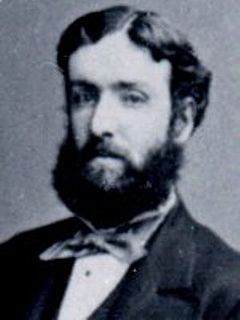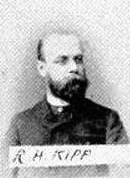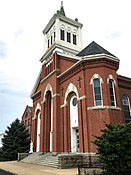
Wilkes-Barre is a city in the U.S. state of Pennsylvania and the county seat of Luzerne County. Located at the center of the Wyoming Valley, it had an estimated population of 40,766 in 2019. It is the second-largest city of the Scranton–Wilkes-Barre–Hazleton, PA Metropolitan Statistical Area, which had a population of 563,631 as of the 2010 Census and is the fourth-largest metropolitan area in Pennsylvania. Wilkes-Barre and the surrounding Wyoming Valley are framed by the Pocono Mountains to the east, the Endless Mountains to the north and west, and the Lehigh Valley to the south. The Susquehanna River flows through the center of the valley and defines the northwestern border of the city.

Luzerne County is a county in the Commonwealth of Pennsylvania. According to the U.S. Census Bureau, the county has a total area of 906 square miles (2,350 km2), of which 890 square miles (2,300 km2) is land and 16 square miles (41 km2) is water. It is Northeastern Pennsylvania's second-largest county by total area. As of the 2010 census, the population was 320,918, making it the most populous county in the northeastern part of the state. The county seat and largest city is Wilkes-Barre. Other populous communities include Hazleton, Kingston, Nanticoke, and Pittston. Luzerne County is included in the Scranton–Wilkes-Barre–Hazleton Metropolitan Statistical Area, which has a total population of 555,426.

Hanover Township is a township in Luzerne County, Pennsylvania, United States. As of the 2010 census, the population was 11,076, making it the most populous township in the county.

K.O. Sweeney was the nom de guerre of a New York boxer who fought during the years 1911–1919. The name was coined by Sweeney's manager, Leo P. Flynn, who was known for assigning colorful nicknames to his fighters, including Tommy Bergin, Andy Parker, Johnny Alberts and Bert Stanley. Flynn's nickname for Sweeney was used over the years by several other American boxers.

Bruce Price was an American architect and an innovator in the Shingle Style. The stark geometry and compact massing of his cottages in Tuxedo Park, New York, influenced Modernist architects, including Frank Lloyd Wright and Robert Venturi.
The Wilkes-Barre and Eastern Railroad (WB&E) was a railroad that operated in Pennsylvania from 1892 to 1939.

Bishop Franciszek "Francis" Hodur was the founder and first Prime Bishop of the Polish National Catholic Church (PNCC). Ordained by the Roman Catholic church in 1893, Hodur served two parishes in the Scranton diocese before he was excommunicated five years later in 1898 for his release of a National Church program, which called for reformation to canon laws of temporal goods. His excommunication was also a result of his rejection of the dogmas of papal infallibility and supremacy after the Council of Trent. With a congregation of approximately 200 families, he founded the St. Stanislaus Parish in Scranton and celebrated Mass in the polish vernacular of the congregation, instead of Latin, as was common in the Roman Catholic church. Hodur was consecrated a bishop in 1907 with apostolic succession by the bishops of Old Catholic Church and went on to expand the episcopate of the PNCC to manage diocesan affairs and ordain priests therein. Under Hodur, the church expanded to 245 parishes across the United States and Poland. After his death in 1953, he was succeeded by Leon Growchowski, whom he had consecrated in 1924.

Edwin Forrest Durang was an American architect. He kept offices in Philadelphia and specialized in ecclesiastical and theatrical design.
The Pennsylvania State League was an American professional baseball sports league that operated rom 1892 to 1895, then became the first Atlantic League.

Harry Livingston French was an American architect based in Wilkes-Barre, Pennsylvania. He designed in a variety of styles, including the classical and Gothic revival. His built works included numerous banks, schools and armories.

The St. Vincent DePaul Catholic Church, Convent, and School is a historic church located at 46408 Woodward Avenue in Pontiac, Michigan. It was designated a Michigan State Historic Site in 1987 and listed on the National Register of Historic Places in 1989.

Owen McGlynn (1878–1918) was an architect who practiced in Wilkes-Barre, Pennsylvania at the end of the nineteenth century and at the beginning of the twentieth. He designed in a variety of styles, including the classical and Gothic revival. His built works included numerous banks, schools and churches.

The Cathedral Church of the Nativity is an Episcopal cathedral in Bethlehem, Pennsylvania, United States. It is the seat of the Diocese of Bethlehem. In 1988 it was listed as a contributing property in the Fountain Hill Historic District on the National Register of Historic Places.
Plymouth, Pennsylvania sits on the west side of Pennsylvania's Wyoming Valley, wedged between the Susquehanna River and the Shawnee Mountain range. Just below the mountain are hills that surround the town and form a natural amphitheater that separates the town from the rest of the valley. Below the hills, the flat lands are formed in the shape of a frying pan, the pan being the Shawnee flats, once the center of the town's agricultural activities, and the handle being a spit of narrow land extending east from the flats, where the center of town is located. At the beginning of the 19th century, Plymouth's primary industry was agriculture. However, vast anthracite coal beds lay below the surface at various depths, and by the 1850s, coal mining became the town's primary occupation.
Plymouth, Pennsylvania sits on the west side of Pennsylvania's Wyoming Valley, wedged between the Susquehanna River and the Shawnee Mountain range. Just below the mountain are hills that surround the town and form a natural amphitheater that separates the town from the rest of the valley. Below the hills, the flat lands are formed in the shape of a frying pan, the pan being the Shawnee flats, once the center of the town's agricultural activities, and the handle being a spit of narrow land extending east from the flats, where the center of town is located. At the beginning of the 19th century, Plymouth's primary industry was agriculture. However, vast anthracite coal beds lay below the surface at various depths, and by the 1850s, coal mining became the town's primary occupation.
Thomas Podmore (1859–1948) was an architect from Wilkes-Barre, Pennsylvania. In addition to his lengthy architectural career as an architect, Podmore is noteworthy for his experiments with the fabrication of concrete products.

Albert Hamilton Kipp was an architect from Wilkes-Barre, Pennsylvania.
Mary Louella Trescott (1861–1935) was a legal rights attorney and the first woman appointed to local, state, and Federal judicial positions in Luzerne County, Pennsylvania. Trescott's education and positions were achieved before 1920 when ratification of the 19th Amendment granted American women the right to vote.


















